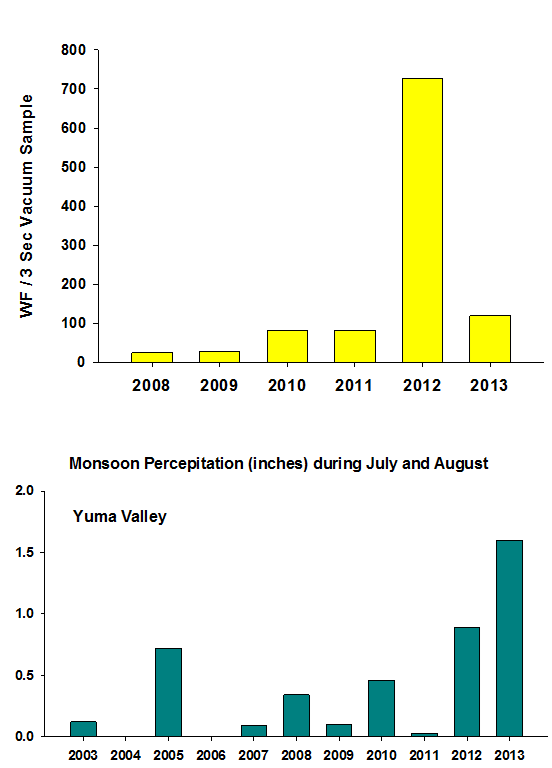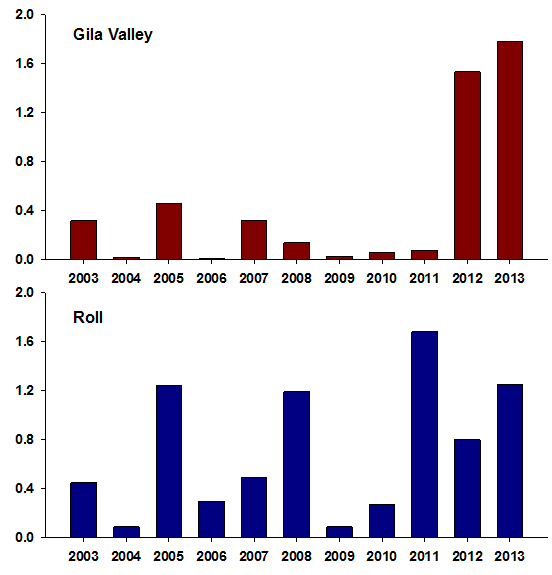
|
|
|
|

|
|||
|
|
|||
|
During the past week, whitefly adult numbers on fall melons have been predictably high in plots here at the Yuma Ag Center. Surprisingly, adult numbers were low at stand establishment (Aug 15 wet date), but have increased significantly following the recent series of storms we’ve experienced in the area (Aug 26-30). However, whitefly populations are lower than what we experienced in our experimental plots this time last year based on vacuum samples taken this week (see graph below). A similar trend has also been observed on melons in the Roll/Tacna area where sampling has shown numbers in excess of 100 per leaf on pre-blooming plants in some fields. In the Roll area (43E), one sticky trap caught almost 18,000 WF in a one week period (Aug 24-31). These large whitefly populations can be attributed to a large extent to the crop landscape throughout Yuma. Crops planted near or adjacent to cotton and alfalfa are clearly more heavily infested than fields isolated away from these crops. In addition, our monsoon conditions this year may be playing a role where total rainfall and average relative humidity during July and August have been higher this year than in the previous 10 years. Interestingly, these monsoon conditions were also relatively high in 2005 where, if you recall we had very heavy whitefly that year. Given that whitefly pressure does not appear to be letting up, PCAs should pay particular attention to early whitefly control on their newly planted produce crops. It is important that PCAs prevent prolonged feeding by high numbers of adults on seedling lettuce plants which can cause stunted growth. If you observe honeydew on leaves in the absence of nymphs then there are way too many adults on the seedling plants. With the loss of endosulfan, growers have few options for effective adult control, but good knockdown can be achieved on lettuce and cole crops with combinations of bifenthrin (e.g. Brigade, Sniper, Discipline, etc.) or Danitol tank-mixed with Orthene, Lannate, Lorsban, Venom, Scorpion, and Assail. These combinations will also provide good control of Bagrada bugs on cole crops. Furthermore, allowing adults to remain unchecked on small plants generally results in the development of large nymph populations that can cause significant growth/yield reductions in all produce crops. It is strongly recommended that growers apply a soil neonicotinoid on lettuce and cole crops throughout September and early October. Local research has shown that imidacloprid applied at 0.25 lbs AI/ac at planting provides less residual control of nymphs today than it did 10 years ago. Given the current economics of imidacloprid, cost-effective whitefly control can be achieved by using higher rates of imidacloprid (0.38 lbs. AI/ac) to extend residual control (e.g., Alias 2F-24 oz; Wrangler 4F-12 oz; Admire Pro- 10.5 oz). Once plants get larger, products like Movento, Venom, Scorpion, Assail, Actara, Knack and Courier/Vetica can provide effective control of nymphs. For more information on whitefly biology, management and insecticide alternatives see these reports: Whitefly Management in Leafy Vegetables, Cole Crops and Melons - Fall 2013 and Insect Management on Desert Vegetables and Melons: Whitefly.
Remember: "When in Doubt…… Scout"
Click picture to listen to John’s update
To contact John Palumbo go to: jpalumbo@ag.arizona.edu |
|||
| Back | |||
|
For questions or comments on any of the topics please contact Marco Pena at the Yuma Agricultural Center.
|
|||
|
Home |
Cotton | Veggies |
Forages | Grains
| Citrus |
Crop x Crop Insects | Diseases| Weeds | Pesticides | Economics | News | Weather | Research | Photos | Contacts | General Info. Copyright © 2001 University of Arizona, College of Agriculture and Life Sciences Webmaster: Al Fournier (acis@ag.arizona.edu) |
|||


